|

AUGUST 2019

H. Strehm,
34th Street
Ferry, 1910
New York
Public Library Digital Collection
Hicksville
Becomes a Suburb (Part I)
Can you imagine a
Hicksville
with no commuters?
I don't know if there ever was a
Hicksville
like that, but for many, many years, there was something that closely
resembled it. In the
beginning, commuting between
Manhattan
and
Long Island
was difficult. It remained
difficult for most people until September 8, 1910, after which many more
residents of
Nassau
and
Suffolk
could seek careers in
Manhattan
, and people who worked in
Manhattan
could dream about homes on
Long Island
. The door had been opened.
The change was so significant that the editors of the
Huntington
Long-Islander saw fit to announce it this way:
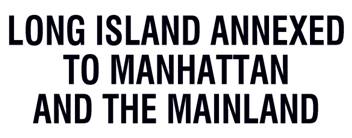
Let's
look at how things worked out that way.
We'll begin about 190 years ago.
***
A Railroad Station at Nowhere
In their Images
of America Series book about
Hicksville
, historians Richard and Anne Evers look back to the 19th
century, and they see a village which they describe as "an emerging
railroad community." Those
are pregnant words, for they emphasize how entwined
Hicksville
and the LIRR have been since
their contemporaneous origins. Note:
See the Appendices at the end of this article for a discussion of the
relevance of the Williams land purchase to
Hicksville
's birth.
In the early 1830s, Valentine Hicks, a
member of the Board of Directors of the new Long
Island Railroad, and later the road's President, spurred the
creation of a new "
New York
to
Boston
" route. It would be five
hours faster than traveling all the way by water, which at that time was
the quickest way. LIRR
trains would take passengers to Greenport, from which LIRR ferries would deliver them to
Boston
. The line's investors
were not interested in the railroad's serving any towns which the
Greenport trains might pass along the way.
They just wanted a fast, direct route, and they wouldn't pay
for anything beyond that. Thus,
the route to Greenport would be as straight as possible, and indifferent
to any towns it happened to go near.
East of Jamaica, it would go through the Hempstead Plains -
flat, open, and mostly unpopulated.
Curiously, there would be a few stops, perhaps made because early
steam locomotives often had to replenish fuel and water, and these stops
would be at obscure places like Clowesville.
*
The investors were short-sighted.
They ought to have realized that the express service would keep
any given stretch of track busy for only a fraction of the time.
Idle tracks produce no revenue.
It would make sense to introduce local service to the communities
along the route, allowing their residents to travel and ship goods -
except, of course, that the railroad was being built where there would
be no communities along its route. Anticipating
this problem,* the enterprising Mr. Hicks took advantage of it.
He formed a land association to purchase undeveloped
Long Island
real estate. Once the
railroad got going, once-useless properties could be sold at a profit,
as new communities sprouted up along the line.
Hicks' future looked bright indeed.
*Anticipating it, or deliberately
creating it? The
railroad's strategy of bypassing existing towns may have actually been
an effort to enrich the members of the land association.
*
In 1836, things went sideways for a
great many Americans, including Valentine Hicks.
For years, Andrew Jackson had fought strenuously in Congress
against the Federal government's Second
Bank of the
United States
. As President, he
ensured that the Federal bank would cease to exist in 1836.
The resulting instability had changed
American banking practices, such that payments for large commercial
loans often were tied to the Bank
of
England
's lending rate. When
the latter found it necessary to repeatedly increase that rate, American
business, debt-laden and overstretched, could not make its loan
payments. Within months, the
whole country was mired in the Panic
of 1837, a severe crisis that would endure for seven years.
No one could get investment capital, and the railroad was forced
to wind down construction.
Work on the new tracks temporarily
ceased. The place where the
rails ended was desolate; even the
Hicksville
Historical Society's web
page calls it "the middle of nowhere."
That was true enough, but there was something positive to be said
about the spot: people passed through it a lot.
Near the impromptu end of the line, the New Bridge Road met the
Jerusalem-Jericho Road, as did the Massapequa Road, the combined
intersections forming the distinctive birdsfoot-like pattern that long
has characterized maps of the core of Hicksville:

Not a lopsided Peace
Symbol, but the intersection at which
Hicksville
began
This eloquent artwork created by the author
With the connection to Greenport
postponed indefinitely, the LIRR
needed another source of revenue, and it changed its mind - it would
introduce local service. The
well-worn converging roads would keep bringing travelers right past the
end of the line, and those travelers would realize that they could find
the railroad useful now and then. A tiny depot was built where the track
ended, with a sign that bore a brand-new name:
Hicksville
.
Some years later, construction of the
Boston
connection resumed. Rail
service to Greenport began in 1844, with trains stopping at intermediate
towns, as shown in the timetable below.
Boat service between
Boston
and Greenport, and special express rail service, would be introduced
soon thereafter.
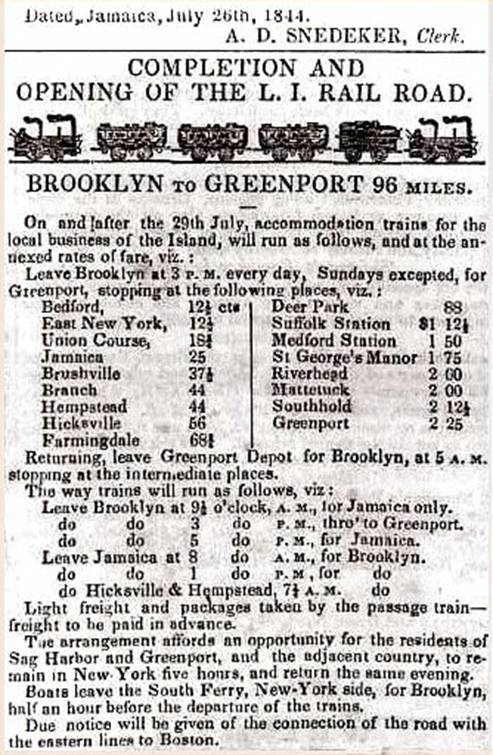
Yes, the
U.S.
once minted half-cent coins.
Wikipedia entry for LIRR
There were not many trains, a sign of how sparsely
populated
Long Island
was. As an example, the 1830
U.S. Census indicates that the entire
Township
of
Oyster Bay
had a population of only 5,200.
***
Fast-Forwarding
In the end, the Boston-NY service was a success for
some years - until it was rendered obsolete by the building of the
New York
,
New Haven
, and
Hartford
Railroad.
Hicksville
developed into a small but robust village, with everything a village
should have: homes, churches, a schoolhouse, some light industry, a few
shops, and farms. The LIRR had helped the village grow.
For example, farmers could ship produce westward by rail, and
they could have equipment, building materials, and other supplies
brought to town the same way. Around
the 1850s, the arrival of a number of new immigrants helped the
population grow some more. The
newcomers brought with them some new things, like the gold-beating
industry, and resort hotels for city folk who wanted to come east to
relax, hunt, and sleigh.
By
1900, the population of the
Township
of
Oyster Bay
had tripled, but
Hicksville
remained basically rural. There
were large farms, and several agriculture-related businesses, including
the very large A.J. Heinz facility.
Looking back at the local newspapers, one sees that village
residents had little difficulty taking pleasure trips into the City, or
having friends from there come out to visit once in a while (both things
being so unusual that the newspapers mentioned them).
In 2019, one feels nostalgia about people once having been able
to enjoy a rural existence so close to
Manhattan
. But the more one
contemplates that, the more one starts to ask questions.
Where did commuters live? Why
were there so few of them?
***
Water
Barrier
As can be seen in the timetable shown
earlier, the original western end of the LIRR
was in Brooklyn; even the successful
Boston
-
New York
service never touched
Manhattan
. In the 1830s, the
technologies and materials needed to construct tunnels under the river,
or long bridges with clear spans over it, did not yet exist.
Until that situation changed,
Manhattan
(except for a small corner of its northern end) would remain bounded by
too much water for it to be connected to other land masses.
One had to reach it by boat.
*
Early 1800s lithographs of
New York
Harbor
are usually picturesque scenes, dotted willy-nilly with toy-like boats.
I think the intent was to depict the craziness of
New York
's water traffic. There
were three-masters galore, little commercial schooners running errands,
paddle-wheelers traveling up and down the river, one-man boats powered
by sail (or oars!), and ferries forever shuttling between the shores.

David William Moody, View of Brooklyn, L.I. from
U.S.
Hotel, N.Y., 1846
New York
Public Library Digital Collection
If you were a businessman setting out
on a fast trip to
Boston
, you might not think twice of taking a ferry over to
Brooklyn
to start the trip. That was
the 1840's equivalent of taking a cab to the airport for a flight to
California
.
If instead you were a clerk in an office, or a courier, you might
find cheaper accommodation across the river than downtown.
You would travel over the river twice a day, on a cheap, perhaps
uncomfortable vessel. The
ferry trip was the entirety (or maybe in some cases, the majority) of
your commute. You accepted
it as it was, because using it enabled you to live in better quarters
than you could get for the same money in
Manhattan
.
*
If you were an occasional visitor to
downtown - say, someone who lived in Queens or further east - who
came to Manhattan once or twice a year on business... well, then you had
a long journey before you got to the river, and the ferry would cover
less distance per minute than anything else you rode on that day.
Ferries were not "big fish" in the river; they had to yield
the right-of-way to river steamers, tugs, and ocean-going tall ships.
You might have to wait a long time for your ferry because earlier
crossings had put it behind schedule.
Although an ideal crossing in a good steam ferry could take only
a half hour, waiting to board, harbor congestion, rough water, fog, or
mechanical issues could double the expected elapsed time.
The quality of the ride was inferior to what one experienced on a
train, and perhaps even on a horse-drawn omnibus.
Steamboats were still fairly new; some ferries instead were team
boats. Picture two
simple wooden sides with a flat wooden roof, mounted on a flat hull,
everything put together to form a long floating box with no ends.
More than 200 passengers could crowd inside, where at the center
stood a team of horses, tethered so that they walked in place on a
turntable. It rotated; a
shaft connected it to a paddlewheel.
The whole boat reeked of its history of hard-working horses and
sweaty passengers, and as it crossed, it would be rocked a little by
each new wave. Team boats
were cheap to build, economical to operate, dependable, and slow.
No one looked forward to riding on them in rush-hour, but the
fare was cheap.
Steamboats were preferable to team boats.
Like the trains of the era, they were thought fast, and they had
risks. Like trains,
steamboats might break down mid-trip - a very significant difference
being that in such situations, ferries would be helplessly adrift on the
water, whereas trains would be stuck where they were.
Like trains, steamboats had boilers, which if carelessly tended
might explode spectacularly. Again,
the outcomes were different; train passengers usually survived, whereas
ferry passengers usually died (the ferry invariably sank).
As late as 1871, 66 people on a
New York
ferry died because of a boiler explosion.
Understandably, when an early 1800s Long Island resident returned
safely home from
Manhattan
, s/he likely felt relieved, tired, and above all, grateful that such
trips were rare.
***
Progress,
But Not For Everybody
As the century continued, things changed, and sometimes they improved.
Trains got more reliable, and they reached their destinations
faster. By 1850, there was a
railroad line in
Manhattan
, running south from the
Bronx
on a bridge across the narrow Spuyten
Duyvil. Ex-ferryman
Cornelius Vanderbilt soon acquired and improved that line, and he
connected it to a few railroads upstate.
People started to commute from the north.
In 1871, profits from Vanderbilt's New
York Central Railroad financed the creation of
Manhattan
's first imposing Grand Central
Depot, which occupied 12 city blocks between
Lexington
and Madison Avenues.
Alas, Long Islanders got no Grand
Central equivalent, but they did get improved ferry service,
courtesy of the LIRR.
The railroad bought ferries, built a ferry terminal at
Long Island
City
, and established routes to destinations in three different parts of
Manhattan
. By the 1870s, the railroad
had improved things further by introducing faster, more stable
double-ended ferries, with iron hulls.
|
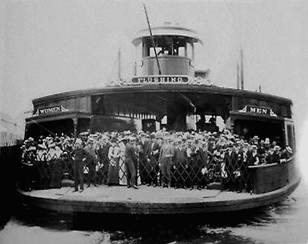
picclick.com
|
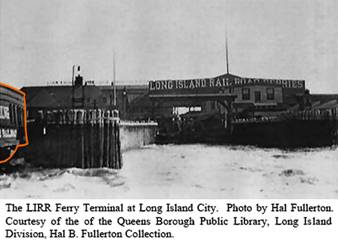
Long
Island
Historical Journal, Volume 17, Nos. 1-2
|
|
The
Flushing
, an iron-hulled LIRR side-wheeler ferry built in the 1870s.
The sides of its bulging upper hull concealed the upper
portions of its paddle-wheels.
|
An
imposing venue, no?
Highlighted on the left is a corner of the same ferry boat, the
Flushing
.
|
Meanwhile, elevated trains began connecting
Manhattan
neighborhoods in the 1870s, making more workplaces accessible to river
ferries. In 1883, the
Brooklyn
Bridge
made it possible for those who worked south of Wall Street to live
further away from
Manhattan
. Streetcars ran from the
City Hall area in
Manhattan
over the bridge to Brooklyn (near the LIRR
terminal) and beyond, into
Queens
. In 1904, the first NYC
subway opened, speedily connecting more neighborhoods in
Manhattan
. More
New York City
jobs than ever were within reach of ferry commuters.
The
ferries, however, could not keep up.
Only so many ferries could safely travel in close proximity at
any given spot in the harbor. The
faster ferries went, the more space they needed between them.
The bigger their passenger capacity, the slower they went, and
the more time they needed to load and unload.
It seemed that the
East River
ferry services could never move enough people fast enough to cease being
an impediment to long-distance commuting.
*
New
York City
took bold steps to improve
East River
movement between Boroughs. By
1910, there would be four bridges across the East River, all of them
moving people via public transit (all carried streetcar lines; three of
them also carried either elevated lines, or subway lines on above-ground
forays). Intra-city
commuting was booming.
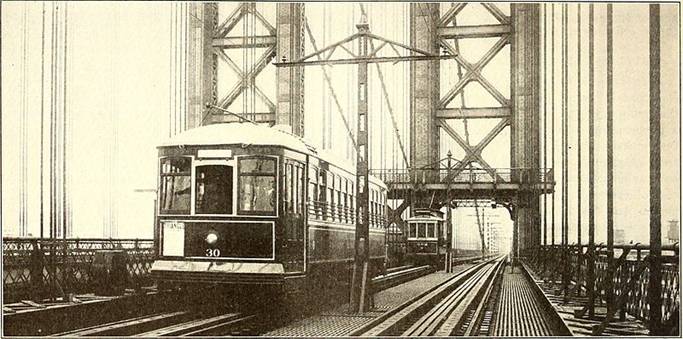
Streetcars
on the
Manhattan
Bridge
; subways also traveled across the bridge
Smithsonian.org
Hudson River
ferry services prepared for their demise as construction of tunnels for
the Hudson and Manhattan Railroad
(the predecessor to PATH) progressed. When
the line opened in 1908, mainland commuters could reach
Manhattan
via rail from both the Bronx and
New Jersey
. Unless they found ways to
get from the LIRR to local
transit lines over bridges, Long Islanders still had to resort to ferries
in order to set foot on
Manhattan
.
***
The
Change
For decades, several interstate railroads (other
than the New York Central) had
offered "
New York
service" by connecting to ferry terminals in
New Jersey
. They did not dare attempt to
actually cross the
Hudson
. The financing needed for a
railroad to move scores of passenger trains daily between
Manhattan
and the mainland over or under the
Hudson River
would be astronomical, and a bridge or tunnel of the requisite length
would be without precedent.

Exchange
Street
Ferry Terminal
Wikipedia
And then the Hudson
and Manhattan demonstrated that technology finally existed to build a
safe, workable rail tunnel under the
Hudson
. The Pennsylvania
Railroad, long jealous of its arch-rival New York Central, was one of the wealthiest railroads in the
country; it decided to undertake such a project.
New York
passengers on the Pennsy's
"name" trains finally would be able to sit in their luxurious parlor-car
seats and ride end-to-end between
Manhattan
and say,
Chicago
,
Philadelphia
, or
Washington
D.C.
, without even hearing the word "ferry" mentioned once.
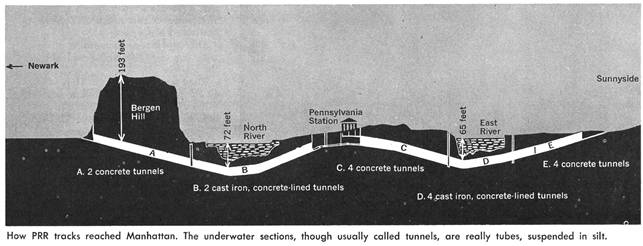
PCPOST HudsonRiverTubes Diagram.png
Wikimedia Commons
That was the concept of the project, but there was more to making it real.
There would be collateral impacts, for the
Pennsylvania
would need storage and service facilities east of the new station.
That meant constructing the first tunnels under the East River, to
extend the tracks through the new station into
Queens
. It also meant the Pennsy
would acquire control
of the
Long Island, and expand the
latter's property in
Queens
into the world's largest passenger rail yard.
There also would be tunnels for the LIRR's
use, and dedicated LIRR tracks
at the new Penn Station.
Long Island riders would
finally get to say "goodbye" to the
East River
ferries.
On
September 8, 1910, when a Long
Island train became the first train to ever use Pennsylvania
Station, people all over the
Island
celebrated. On that first day,
many Long Islanders rode the trains through the tunnels to
Manhattan
and back, just to be able to brag about it afterwards.
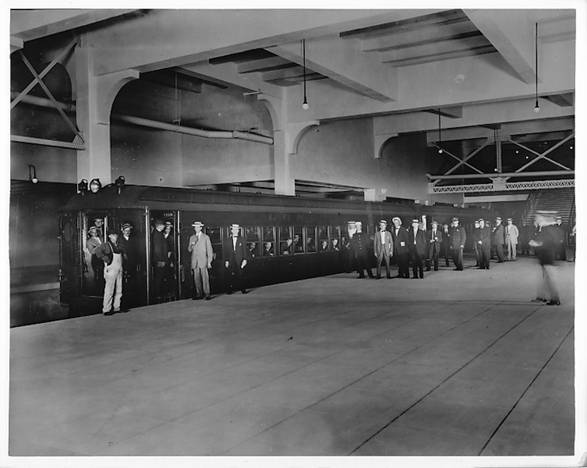
The first passengers to arrive in
Pennsylvania
Station
untappedcities.com
Others
went down to local stations all over the LIRR
and waited, which raises an interesting point.
Did these people realize what they were waiting for?
Only electric-powered trains were allowed in the new tunnels, but only
part of the LIRR used such
trains. Most of the railroad
relied on steam locomotives, which meant that people who waited at, say,
Hicksville
or Northport would be greeting steam trains, which had not passed through
the tunnels. People coming
back to those stations from
Manhattan
had to change trains at
Jamaica
(Who could have guessed?J).
So, the people who celebrated in the photograph below, with their
flags and perhaps their picnic baskets, were at the station to welcome
neighbors and friends who had ridden through the tunnel, just not on the
trains that brought them home.

People waiting in Northport to greet passengers who
rode through the new tunnels on their
first day of service. This train
would have passed through
Hicksville
en route to Northport.
Steel Rails to the
Sunrise
***
Excitement
It is not hard to understand what the change meant
to the people of
Hicksville
. Regular travel between home
and
New York
now was feasible for just about everybody, because the tunnels had cut at
least an hour off a day's total commute to midtown.
More Long Islanders could work in
Manhattan
now, and more people who already worked there could think of moving to
Long Island
. In its
Hicksville
pages, the Long-Islander rhapsodized about the possibilities:
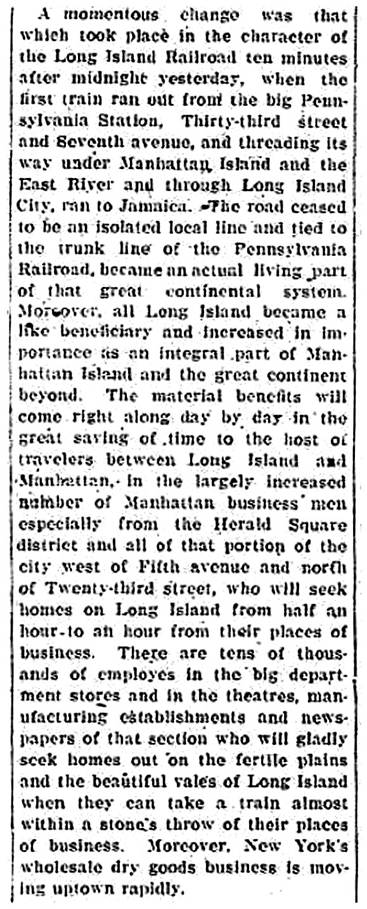
***
With
Hicksville
now squarely in commuting country, its transformation could begin.
Next month, Ancient Hixtory will discuss the start of suburban
Hicksville
, and how it changed in the years before World War I.
Not surprisingly, newspapers (no doubt encouraged by real estate
agents and developers) took the lead in marketing the future suburbs.
Among other things, we'll look at a prominent newspaper article
that appeared about a year after the tunnels opened, and see what it says
(and what it fails to say) about moving to Hicksville.
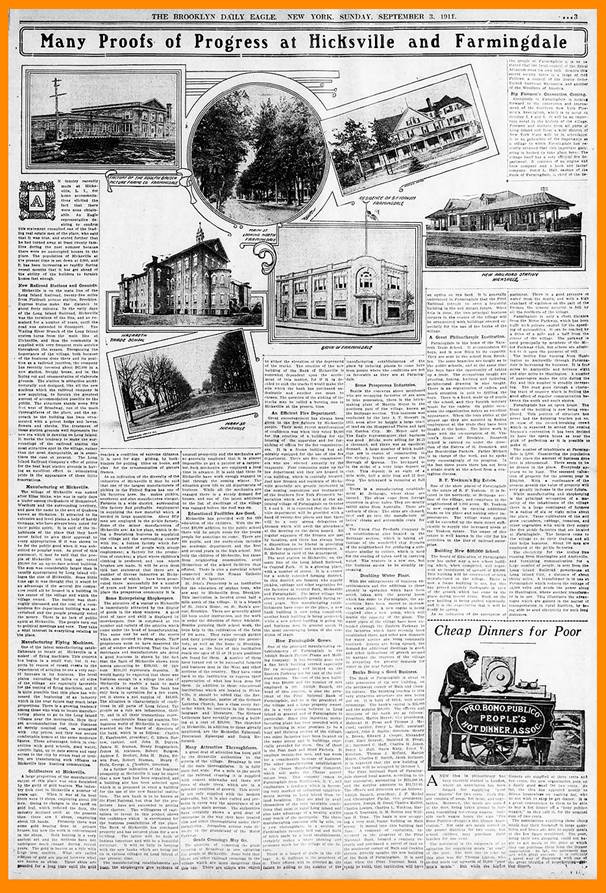
Brooklyn
Daily Eagle, September 3, 1911
End of Part I
***
Appendix 1: Unintended Village
Even without a railroad,
Hicksville
might have taken root at that ungainly intersection.
But as events unfurled, three fundamental ironies, unintended
consequences of actions taken elsewhere, played crucial parts in
Hicksville
's history:
|
1.
|
The railroad that triggered the
permanent settlement of Hicksville was focused on quickly moving
people between
Boston
and
Manhattan
. It had intended to
ignore the spot on which
Hicksville
took root.
|
|
2.
|
The reason the village developed when
and where it did was a nationwide calamity, prompted by the Bank of
England's raising its lending rates.
One suspects that the British bankers did not have
Hicksville
in mind when they set their new rates.
|
|
3.
|
Hicksville finally was able to begin
transforming itself into a thriving suburb because a railroad on the
mainland, one which had no interest at all in Hicksville, decided to
take its trains across a river on the opposite side of Manhattan from
the LIRR.
|
***
Appendix
2: How Many Candles for
Hicksville
's Cake?
In 1648, Robert Williams purchased a
large piece of land from the Matinecock, land which today includes all or
parts of Hicksville,
Plainview
,
Jericho
, Woodbury, and Syosset. Because
of this, the year 1648 has become enshrined in the minds of Hicksvillians,
so much so that significant anniversaries of it have been celebrated over
the years (e.g., the ceremonies held in 1948 and 1998), as if they
actually marked the village's age. While
commemorating the purchase is a worthy thing, it may lead people to think
that
Hicksville
now is 371 years old (especially since the 1948 celebration was referred
to as Hicksville's Tercentennial).
The British and Dutch had explored much of
Long Island
before the purchase; Williams knew first-hand what he was buying.
Villages were ready to congeal, especially where there were springs
or ponds (e.g.,
Jericho
) - villages that soon would add churches and inns to their houses.
Footpaths (later widened into roads) crisscrossed the area,
connecting places that were populated.
Today, many of those old routes are still important, and some of
the towns they connect boast of landmarks preserved since the 17th
and 18th centuries - but not every town that today occupies
the land which Williams purchased had been settled by 1648.
I am not aware of any remnants of an organized 17th
century village on the site of today's
Hicksville
. I have read that early
residents of
Jericho
used the barren grasslands to the south as pasture, but that's part of
Jericho
's history. It is possible
that in the early decades, cabins or houses were sometimes built within
the borders of today's
Hicksville
, but what of it? An isolated
family home, especially one that fell into ruin and left the surrounding
area devoid of settlers, certainly was not the beginning of a village.
I am not aware of any continuity between people who might have
lived on the land in that manner in the 17th century, and the
people who settled where the roads intersected c. 1837, thereby starting a
thriving community that persists today.
Respected local historians Richard and Anne Evers'
book refers to the Williams Purchase as the
start of
Hicksville
's "documentary history"
(emphasis added) - that is, the purchase is not the start of the
village's history, but part of the prequel.
As noted earlier, the same book calls 19th
century
Hicksville
"an emerging railroad community," acknowledging that what prompted its
initial settlement was the railroad, which arrived in the area in 1836 or
1837. Together, these
statements seem to make clear that the date of the Williams Purchase
should not be confused with the birth of
Hicksville
.
Sorry
Hicksville
; you're only about half as old as some people might think.
*****
See you in September
|














